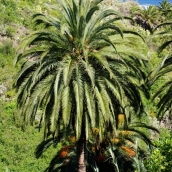Palm, Canary Islands date palm (Phoenix canariensis)
Palm tree, generally to 12-15 m, although it can grow to 30 m, with a dense crown of leaves that are numerous, arched and up to 7 m long; rachis spinose at base. Fruits (dates or clusters of dates), orangey-brown, elliptic and up to 2 cm long. The Canary Islands date palm is native to the Canaries and grows naturally throughout the islands. The finest samples are found in La Gomera and Gran Canaria. Some current palm tree groves are mixed plantations of Canary Islands date palm and date palms (Phoenix dactylifera). Typical of ravines, valleys and hillsides with some atmospheric moisture, optimum conditions are from sea level to 600 m, but palms can be found up to 1,000 m. Hybridization with the date palm is a common practice, resulting in hybrid specimens (essentially bluish-green), which are branched from the base. Interestingly, the seeds of this species are scattered by certain birds, particularly the common blackbird (Turdus merula). Moreover, the Canary Islands date palm, along with the Atlantic canary (Serinus canarius), is one of the natural symbols of the Canary Islands, and is grown in extensive plantations in Italy, the USA and New Zealand.













